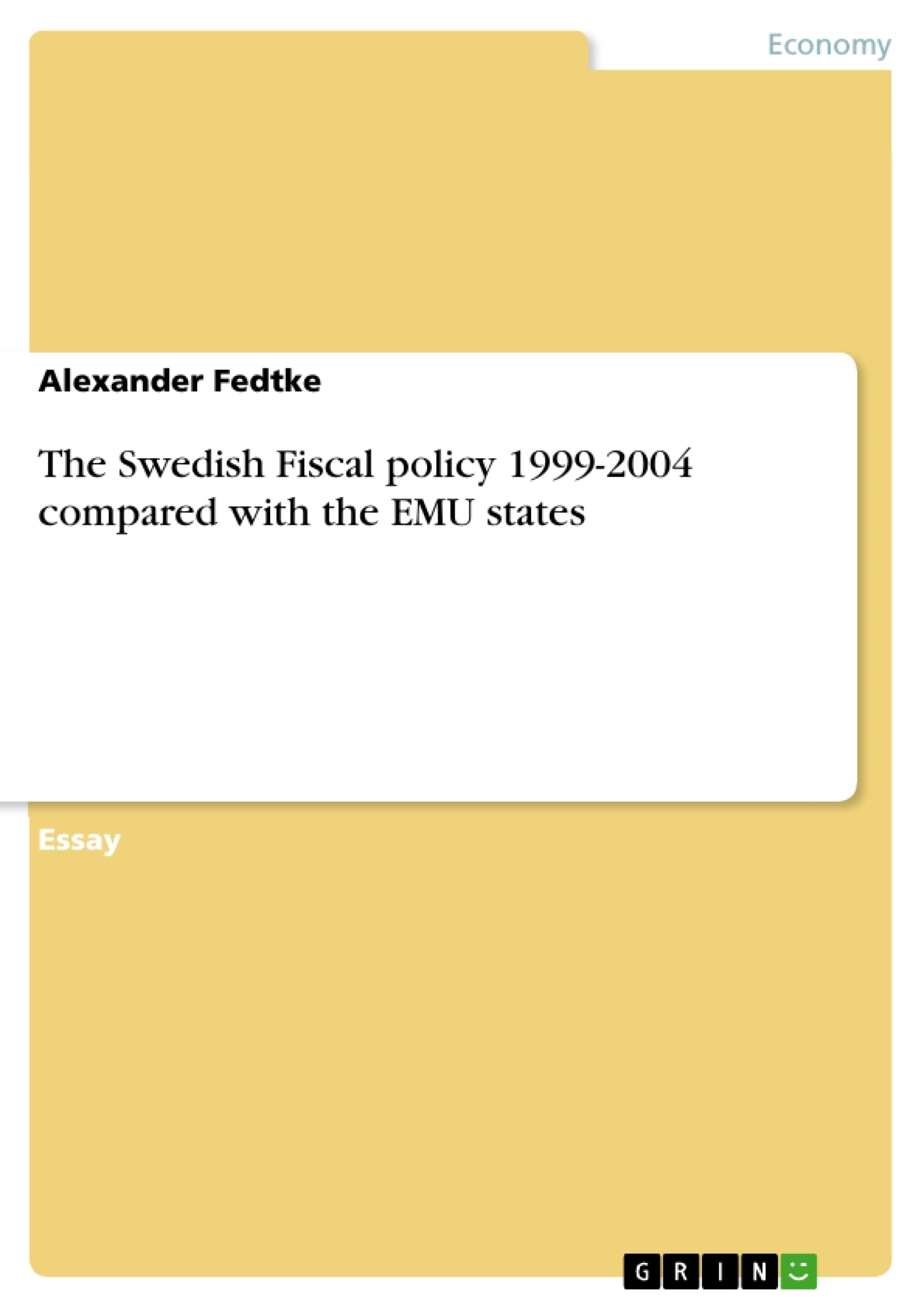I choose the topic “The Swedish Fiscal policy 1999-2004 compared with the EMU states.” Because I want to find out whether the Swedish fiscal policy was counter-cycle compared to the EMU states1 or not. The EMU states have the Stability and Growth Pact (SGP) which set rules for their fiscal policies the pact was introduced in 1999 with the start of the EURO in 1999 began a change and the last actual data I found was 2004 that’s why I choose this period.
Among other things I want to figure out if the SGP has a negative effect on the fiscal policy in a recession.
I start the paper with presenting the so called “Swedish Model” and the changes and development of the 1990s. Then I will present the Institutional framework in Sweden and the Budget process.
After this I will present a definition of fiscal policy and start with the examination of the Swedish fiscal policy 1999-2004 present the methods I use and analysis the period. Then I compare the Swedish development with the EMU states and try to find out if the SGP has a pro-cyclical effect on the fiscal policy this would mean for example in a recession that the downtown takes longer and the economic fluctuation is stronger than without the SGP.
In the end I present my conclusion and have a brief discussion.
In this paper I will not cover aspects of tax development, labour market and monetary policies because of the lack of space.
Inhaltsverzeichnis (Table of Contents)
- Introduction
- The Swedish Model and the development/changes of the 1990s
- Institutional framework
- Definition of fiscal policy
- Sweden's and EMU fiscal policy between 1999-2004
- DESCRIPTION OF THE DATA AND SOURCES AND WHAT KIND OF METHODS I USE
- ANALYSIS OF THE SWEDISH FISCAL POLICY DEVELOPMENT 1999-2004
- EXPLANATION OF THE EMU RULES FOR THE FISCAL POLICY (STABILITY AND GROWTH PACT)
- ANALYSIS OF THE EMU MEMBER STATES FISCAL POLICY DEVELOPMENT BETWEEN 1999-2004
- COMPARISON
- Conclusion
- Discussion
Zielsetzung und Themenschwerpunkte (Objectives and Key Themes)
This paper aims to examine the Swedish fiscal policy between 1999-2004, comparing it with the fiscal policies of European Monetary Union (EMU) member states. The primary objective is to determine whether Sweden's fiscal policy was counter-cyclical during this period. The research also seeks to investigate the potential impact of the Stability and Growth Pact (SGP), which was introduced in 1999, on the fiscal policies of EMU states.
- Swedish Fiscal Policy 1999-2004
- EMU States' Fiscal Policies
- Stability and Growth Pact (SGP)
- Counter-Cyclical Fiscal Policy
- Impact of SGP on EMU States' Fiscal Policies
Zusammenfassung der Kapitel (Chapter Summaries)
- Introduction: This chapter introduces the research topic and its significance, outlining the objectives of the study. The focus is on comparing Swedish fiscal policy with that of EMU states, particularly in terms of its counter-cyclical nature. The role of the Stability and Growth Pact (SGP) and its potential influence on fiscal policies are highlighted. The time frame of 1999-2004 is explained based on data availability.
- The Swedish Model and the development/changes of the 1990s: This chapter delves into the concept of the "Swedish Model" and its characteristics, including low unemployment rates, societal equality, and a large public sector. It discusses the development of the model in the 1990s, including the economic crisis of 1990-1993 and subsequent reforms, such as the devaluation of the krona and budget adjustments.
- Institutional framework: This chapter explores the institutional framework governing Swedish fiscal policy, including the principles and rules outlined in the Instrument of Government, the Riksdag Act, and the Budget Act. It details reforms implemented in the 1990s to strengthen the budget process, focusing on expenditure ceilings and a three-year budget cycle.
- Definition of fiscal policy: This chapter provides a concise definition of fiscal policy, laying the groundwork for the subsequent analysis.
- Sweden's and EMU fiscal policy between 1999-2004: This section focuses on the analysis of Swedish fiscal policy during 1999-2004, including the methodology used and the key findings. It also explores the EMU rules for fiscal policy, specifically the Stability and Growth Pact, and analyzes the fiscal policy development of EMU member states during the same period.
Schlüsselwörter (Keywords)
This research centers around the analysis of Swedish fiscal policy, focusing on its counter-cyclical nature compared to EMU member states. Key terms include fiscal policy, Stability and Growth Pact (SGP), counter-cyclical policies, economic fluctuations, European Monetary Union (EMU), and the Swedish Model.
- Quote paper
- Alexander Fedtke (Author), 2006, The Swedish Fiscal policy 1999-2004 compared with the EMU states, Munich, GRIN Verlag, https://www.grin.com/document/58118




